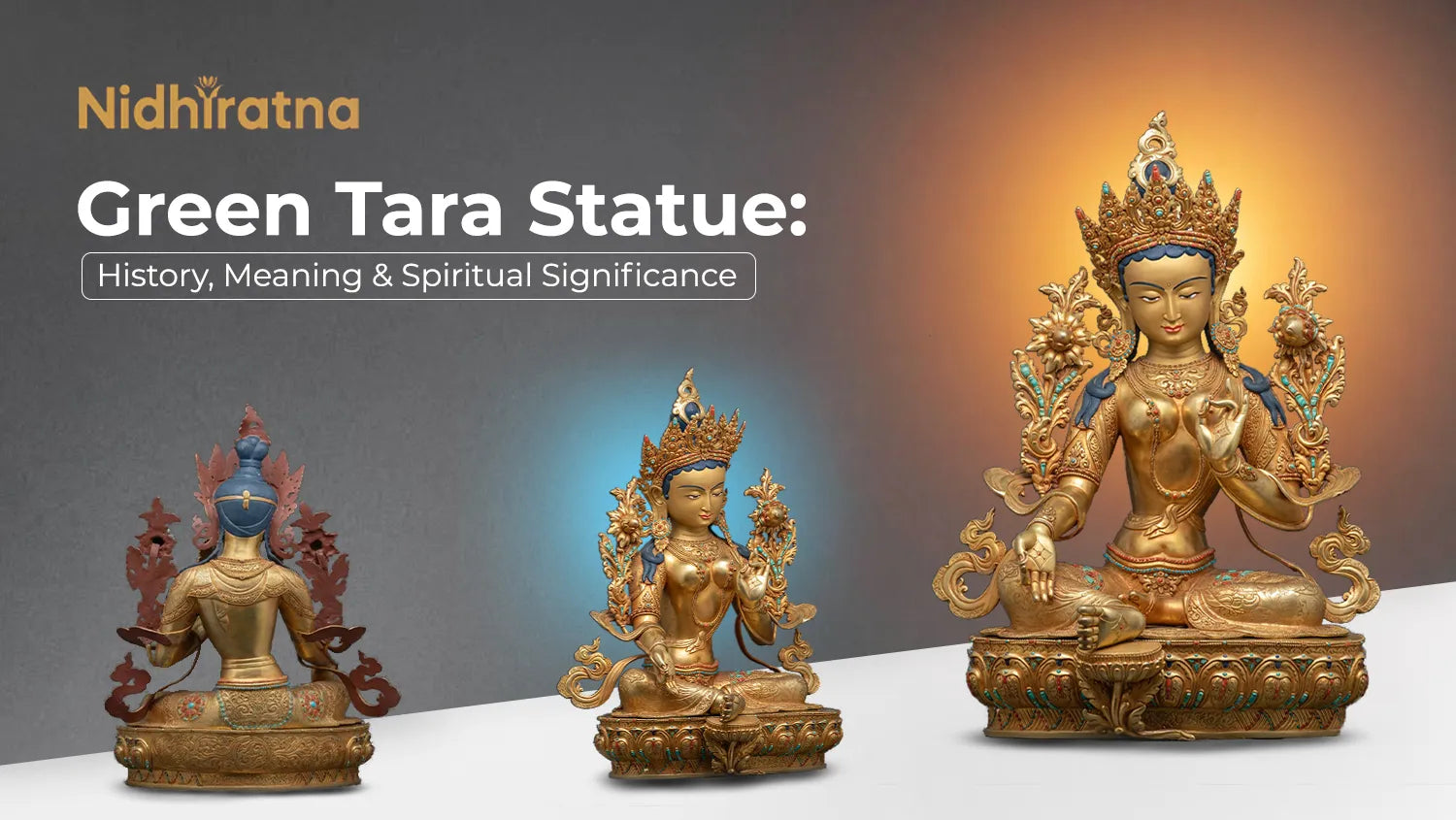Green Tara Statues: History, Meaning and Spiritual Significance
In the great panorama of Buddhist spirituality, few deities shine brighter than Green Tara, the swift protector and savior full of compassion. The Bodhisattva is also known as the Mother of All Buddhas and embodies the dynamic energy of enlightened action and the infinite breadth of compassion. Her Statues and Thangkas can be found around the globe-from temples and monasteries to homes, embodying protection, wisdom, and spiritual liberation.
Ever wondered why Green Tara means so much significance, or what such a brilliant hue as her green really stands for? In this extensive write-up, we will discuss her history, meaning, symbolism and spiritual significance in Tibetan Buddhism.
Who Is Green Tara?
Green Tara (Sanskrit: Syamatara) is one of the most popular figures. Green Tara, a bodhisattva, is someone who has attained enlightenment and made a commitment to help others achieve enlightenment in the Mahayana traditions and the Vajrayana.

According to Buddhist legend, Tara was born from the tears of compassion shed by Avalokiteshvara, known in Tibetan as Chenrezig, the Bodhisattva of Compassion, in response to the immeasurable sufferings of living beings in the realm of Samsara, the world of birth and death. For this reason, she pledged to appear in a female form to bring enlightenment to all living beings.
Her color green represents her compassionate nature: ready for imminent action and assistance, without hesitation. Green Tara is not a goddess lost in the deepest contemplations; she is movement, return, and immediate help.
Historical Significance of Green Tara
Green Tara originated more than a thousand years ago, embedding itself in the wonderful traditions of both Indian and Tibetan Buddhism.
1. Savior From Saṃsāra
Tara is regarded as a savior (Sanskrit: Saviouress) who protects living beings from obstacles caused by physical and spiritual obstacles, such as fears, health problems, and emotional turmoil. This goddess can remove troubles very quickly in response to the prayers of her followers.
2. The Form of Compassion and Wisdom
Tara embodies the absolute union of wisdom and compassion, which are the two highest virtues in Buddhism. While Avalokiteshvara represents compassion, Green Tara is seen as being active energy in compassion, ready to transform that compassion into action.
3. Revered in Tibetan Buddhism
Green Tara is worshipped as one of the most preferred female deities in Tibet, along with White Tara. Green Tara symbolizes an aspiration of limitless kindness manifested through the daily recitation of her mantra: "Om Tare Tuttare Ture Soha." This pronunciation is said to absolve the believer's life of tremendous obstacles and to protect them from all fears, obstacles, and delusions.
Tara represents the absolute union of wisdom and compassion, two of the highest virtues of Buddhism. While Avalokiteshvara represents compassion, Green Tara is also seen as the embodiment of that active energy in compassion, ready to transform empathy into tangible help.
Symbolism of the Green Color in Tara
The green hue of Tara carries rich symbolic meaning in Buddhist philosophy.
1. Energy, Renewal, and Life
Green is the color of life energy and rebirth, representing the energy that gives rise to all forms of life. In this sense, Green Tara figures as a dynamic compassion of renewed hope and healing.
2. Action and Compassion in Harmony
Green Tara expresses movement and active compassion, while White Tara embodies serenity and longevity. Green reminds practitioners that while the action should arise from wisdom, it should also be swift and responsive.
3. Connection with Nature and the Elements
Green Tara also connects to Mother Earth, who nourishes, sustains, and protects all beings, thus cementing her position as a protector of life, bringing growth and renewal to life in both the spiritual and worldly realms.
Spiritual Importance of the Green Tara Statue
The Green Tara statue is not just an object to be worshipped. It is in the spirit of companionship when one meditates, practices mindful awareness, and is initiated in transforming oneself in the internal sense.
1. Depiction and Posture
And here’s how Green Tara usually appears in images: she sits upon a lotus flower, with the lotus meaning purity, the same flower, mind you, which is supposed to be the blossom of enlightenment. Her right leg is extended, showing her willingness to come to the help of others. While the other leg is folded, showing her calm in her practice of meditation.
2. Purity and Enlightenment
The lotus on which the goddess Tara sits represents the path of the soul from ignorance to enlightenment. The symbolism here is to remind one that even in difficult or "muddy" circumstances, it can bloom into wisdom and purity.
3. Development of Spirit and Empowerment
The meditation on or even the chanting of the name of Green Tara evokes Buddhist practitioner the very quality of fearlessness, loving-kindness, and inner peace. The image of Green Tara is normally used in connection with the dispelling of internal obstacles to one's spiritual practice, such as fear, doubt, and attachment and for inducing the development spiritually.
Rituals and Practices Associated with Green Tara
1. The Green Tara Mantra
The most basic and most commonly chanted mantra is:

Om Tare Tuttare Ture Soha
This mantra invokes the blessings of Tara, dispelling fear and liberating one from slavery. Each syllable in this mantra has its own potency: The syllables each have a distinct power:
-
Om - the sacred sound of creation
-
Tare - liberation from suffering
-
Tuttare - protection against fear and danger
-
Ture - swift compassion and enlightenment
-
Soha - sealing the intention and blessings
Chanting this mantra every day promotes courage, healing, and personal change.
2. Tara Puja (Worship)
Devotees perform the Tara Puja ritual everywhere, in both monasteries and homes, through offerings, incense, and prayers. Such ceremonies seek the powerful influence of Tara for protection and guidance in life's obstacles.
3. Meditation and Visualization
Visualizing the original Green Tara, luminous in form and surrounded by green light, emanating the compassion that covers the entire earth, this type of visualization is what Green Tara meditation entails. Then this will focus and illuminate one's attention, compassion, and spiritual awareness.
Benefits of Keeping a Green Tara Statue
The ownership of the Green Tara statue has immense religious and psychological significance.
- Protection from Negative Energies - The Tara is believed to protect from all fear, disease, and negative energies.
- Encourages the Practice of Altruistic Action - Her presence is a reminder of compassion and altruism to the ordinary person in the bustling life he leads.
- Helps to Meditate Better - The presence of a statue in a sacred space further enhances the mindfulness and devotion.
- Attraction of Prosperity and Growth - Spiritually, prosperity and positive change are also associated with the green color.
The Essence of Green Tara's Teachings
Green Tara also teaches practitioners that compassion is not passive; it is active, it is immediate, and it is courageous. The teachings of Green Tara encourage practitioners to consider and act wisely, with all speed, with compassion.
In a world where pain and fear can freeze the heart in paralysis,
Tara's message is timeless:
"Act now with love and courage. For compassion itself is the path to enlightenment."
Where to Look for Real Green Tara Statues
Those who wish to bring this mighty symbol of compassion and wisdom into their lives would benefit greatly from authentic Green Tara statues that would enhance their spiritual space.
Nidhiratna is a trusted marketplace across the world for authentic craftsmanship with various Buddha and Tara statues made by master artisans from Nepal. Each statue has centuries behind it, representing Buddhist art and devotion, an ideal present fit for mediators' rooms, altars, or gifts of deep significance.
Visit Nidhiratna for a luxurious selection of Green Tara statues and other spiritual beings, where faith meets craftsmanship.
Conclusion
The Green Tara Statue means much more than being a holy ornament; it is a living embodiment of compassion in action. Grounded in ancient Buddhist wisdom, Green Tara has inspired millions of people across the world to overcome fear, heal their hearts, and achieve enlightenment. Her green color symbolizes renewal; her posture reflects readiness, while the echoes of her mantra lovingly ring with the eternal truth of love and liberation.
Whether you are seeking spiritual protection, inner growth, or just a gentle reminder to act in kindness, the Green Tara statue is richly inspiring on the path to awakening.
Bring home the energies of compassion and swiftness into your life with authentic Green Tara statues from Nidhiratna and allow her to grace your path toward peace and enlightenment.
Frequently Asked Questions(FAQs)
1. Who is Green Tara in Buddhism?
Green Tara represents an exalted female bodhisattva who stands for the collective virtues of compassion in action. Known as the "Mother of All Buddhas," she immediately reacts to the suffering of all sentient beings and protects them from fear and obstacles.
2. What does the Green Tara statue represent?
The Green Tara statue stands for active compassion, protection, and spiritual development. Green color signifies renewal, vitality, and enlightened deed, while her posture shows her readiness to lend a helping hand to all sentient beings.
3. Why is Green Tara green in color?
The green color stands for energy, nature, and compassionate action. In Buddhist iconography, green specifically represents the motivating aspect of wisdom – the ability to quickly take action to end suffering.
4. What are the benefits of having Green Tara at home?
Green Tara statues promote peace, protection, and prosperity. It promotes compassionate behaviour, allays fear, and furthers meditation and mindfulness practices.


















Share:
The Three Long Life Deities in Tibetan Buddhism: Amitayus, Namgyalma & White Tara